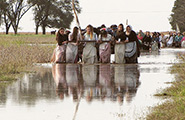Overview | Scheduling | Itinerary | Essentials | Training | Other
Overview
1. In what months are treks allowed at the site?
October to April
2. What is the cost per person to use the site?
No cost
3. How many participants can the site accommodate at a time?
Up to 220 for treks; more for other activities
4. How many handcarts are available?
29
Scheduling
1. Who may schedule a trek? Wards? Stakes? Families?
Stake or district groups of 80 to 180 people are preferred, but missionaries at the site will work with anyone who wants to have a unique experience with the handcarts.
2. How far in advance should treks be scheduled?
Ideally treks are scheduled one year in advance, but six months in advance is sufficient for stakes that are willing to move quickly in planning and preparation.
3. Who is the site contact for more information and scheduling?
Send an email to treksargentina@gmail.com.
4. Are missionaries available to help with treks? What services and activities will they provide?
Missionaries train and coach trekkers, walk with them, and provide drinking water and portable toilets. Missionaries may also teach square dancing and pioneer games. They may provide (or invite others to provide) “trail talks” or firesides about the pioneers.
Itinerary
1. What is the recommended length (in days) of a trek at the site?
Two-day or three-day treks can be scheduled. Both are excellent, but the three-day treks allow youth to have a greater trek experience.
2. How long are the trek trails?
The three-day trek can be about 25 to 27 kilometers.
3. Is the trek a set route, or is there flexibility for different schedules and routes?
There is a normal or set route, but it is subject to change as farm operations and road conditions dictate.
4. What trek activities can be done at the site (such as a river crossing and women’s pull)?
Argentina’s treks include almost everything that stakes in the United States do, such as letters from parents, square dances, pioneer games, trail speakers, firesides, pioneer choirs, pulling handcarts, trek family activities, and a challenging women’s pull that is nearly one kilometer through knee-deep mud and water.
Essentials
1. Is water available at the site? How do groups handle transporting water? Do they bring their own containers?
All campsites have water wells with hand pumps for washing and cleaning. Missionaries also provide a 1,000-liter water tank on a trailer for drinking water. Each person should bring a personal water bottle to fill from the tank.
2. Are pit toilets or portable toilets available on the property? If not, how do trek groups handle sanitation?
The site has eight portable toilets fixed on a flatbed trailer; missionaries use a vehicle to pull the trailer to accommodate the needs of trekkers.
3. How are trek groups to handle trash?
Each handcart is required to have a large bag for trash. Trek groups are required to have a cleanup detail. At the end of the trek, missionaries haul the garbage to the dump.
4. What is the fire protocol at the site?
Open fires are not allowed.
Training
1. Do missionaries from the site provide training to trek leaders? Is the training mandatory? When is it offered? How much does it cost per leader?
Because trekking is new in Argentina, missionaries strongly urge groups that are considering a trek to have the missionaries come to their stake centers to conduct training. Missionaries usually do this training (1) between treks and (2) before closing the camp and returning home, just after Easter. There is no cost to the stakes for this training.
2. Does the site have a site-specific handbook?
There is not a site-specific handbook, but the missionaries provide stake presidents a great deal of information on a Dropbox site. This includes site-specific information, trek planning materials, and many pioneer stories that have been translated into Spanish.
Other
1. Does the site rent handcarts for groups to use at different locations?
Not at this time
2. Are other activities, besides trek, offered at the site?
The main camp is primarily a recreational camp with a swimming pool, soccer field, basketball court, volleyball court, and large pavilion. The site is used for about one FSY program each summer and can accommodate up to 700 people for such programs.

